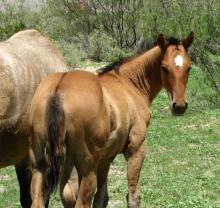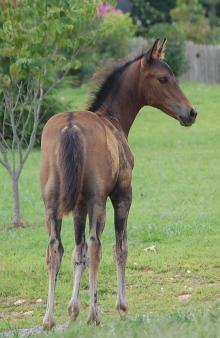Dun or countershading?
This article is pending revision

A dun filly displaying her clearly defined dorsal vs the smudged look of countershading. Photo donated by Cascabel Ranch Performance Arabians

WC DeAlina exhibiting a countershaded dorsal. Photo courtesy of Ancient Oaks Sport Horses
It's quite common for countershading to be confused with dun markings. What is countershading? It's not known what causes countershading type markings but they are believed to be a type of camouflage. Countershading is more common on foals but can appear on adult horses as well. Countershading markings that can closely resemble dun are false dorsals, shoulder bars, and stripes or mottling on the legs. A true dun dorsal will almost always be visible well into the tail while countershaded dorsals will not. It is usually possible for a trained eye to distinguish between the two even on foals but at times even experts can be fooled. The most important thing to remember is that a dun foal must have a dun parent. It is sometimes possible for dun to "hide" in that it can be covered by gray or white patterns but generally speaking if the horse has no dun in its near pedigree then it's not dun but countershading.
Next look at the markings themselves. Are they clear and crisp or do they look as if someone smudged them with an eraser? Looking smudged is usually an indication that they are countershaded. Are the markings clear all year or do they vary with the seasons? Like being smudged a dorsal that appears to come and go with the seasons is an indication of countershading. Probably the color most commonly mistaken for dun is the black foal that is born very gray looking with a black dorsal and even shoulder bars. I know one breeder who was very excited when their palomino mare produced such a "grullo" foal. She was a bit disappointed when her "grullo" foal shed off a wonderful dark black. It is not uncommon for black foals to be born this shade while grullo foals are generally born a buff or light tan.
In order to get a "feel" for dun type markings take a look at our dun photo gallery. You can also take a look at the sooty photo gallery, as sooty is the most common cause for countershaded markings. If you still need more help determining if your horse or foal is dun or countershaded please feel free to post questions to the color genetics forum. We're always happy to help!